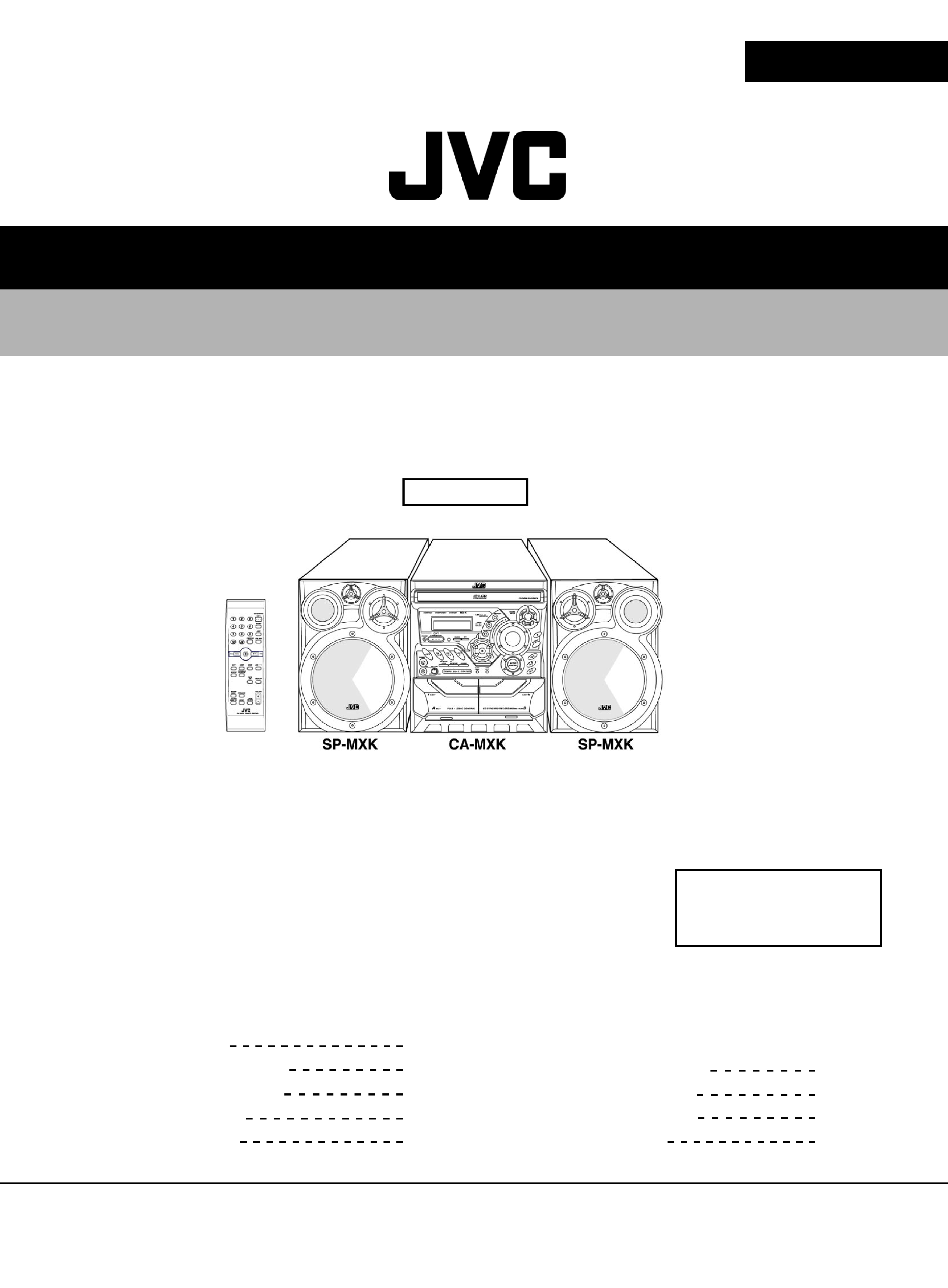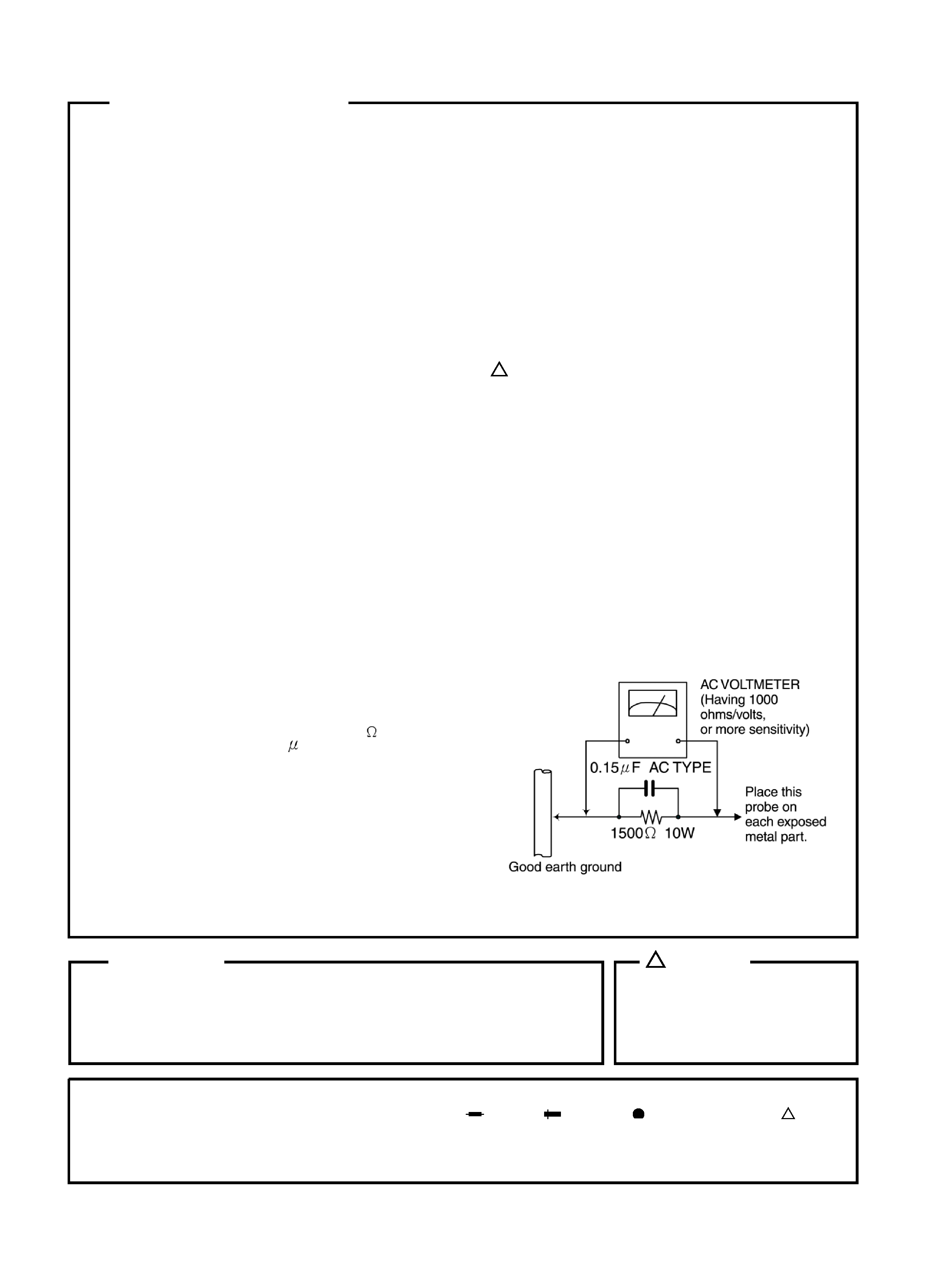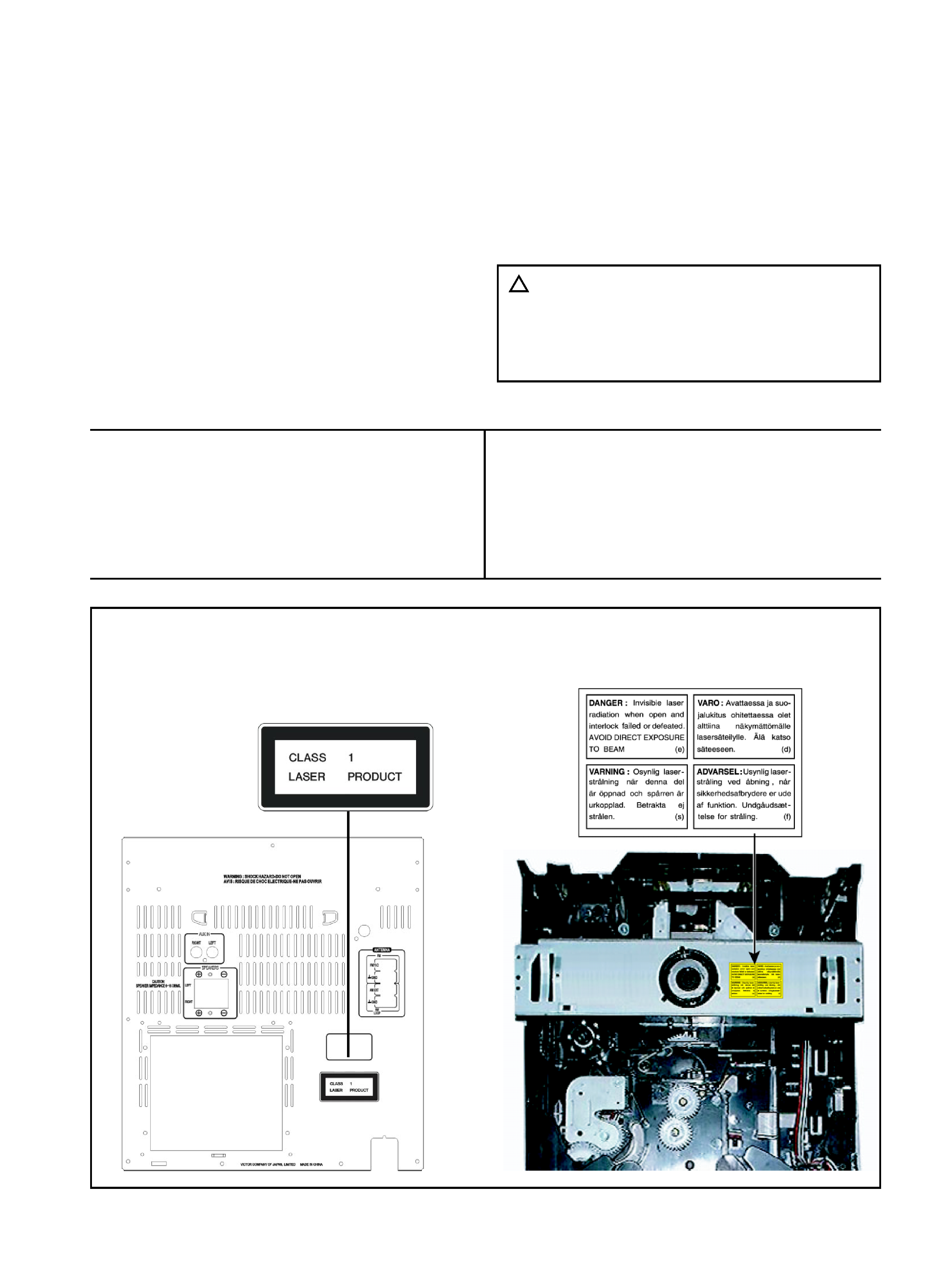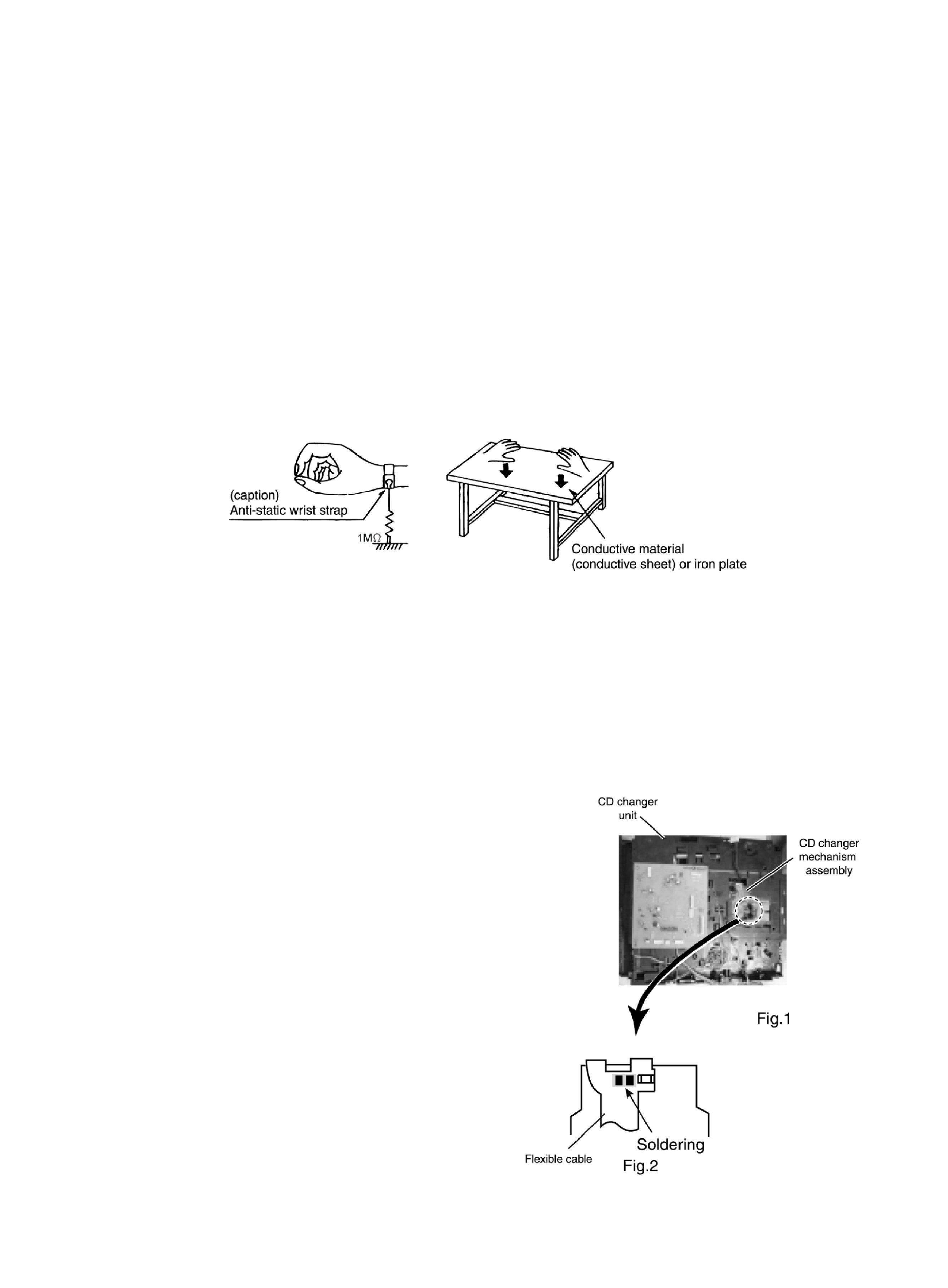
No.21137
Jul.2002
SERVICE MANUAL
COMPACT COMPONENT SYSTEM
MX-K10/30
Flow of functional
operation until TOC read
Maintenance of laser pickup
Replacement of laser pickup
Description of major ICs
1-20
1-21
1-21
1-22
Safety precautions
Important for laser products
Preventing static electricity
Disassembly method
Adjustment method
1- 2
1- 3
1- 4
1- 5
1-18
Contents
COPYRIGHT
© 2001VICTOR COMPANY OF JAPAN, LTD.
Area Suffix
U ................ ASIA
UW .............. LATIN - AMERICA
MX-K10/30
TENTATIVE

1-2
Safety Precautions
Burrs formed during molding may
be left over on some parts of the
chassis. Theref ore, pay attention to
such burrs in the ca se of pref orm-
ing repair of this system.
In regard with component parts appearing on the silk-screen printed side (parts side) of the PWB diagrams, the
parts that are printed over with black such as the resistor (
), diode (
) and ICP ( ) or identified by the " " mark
nearby are critical for safety.
When replacing them, be sure to use the parts of the same type and rating as specified by the manufacturer.
(Except the J and C version)
Warning
1. This equipment has been designed and manufactured to meet international safety standards.
2. It is the legal responsibility of the repairer to ensure that these safety standards are maintained.
3. Repairs must be made in accordance with the relevant safety standards.
4. It is essential that safety critical components are replaced by approved parts.
5. If mains voltage selector is provided, check setting for local voltage.
!
CAUTION
!
1. This design of this product contains special hardware and many circuits and components
specially or safety purposes. For continued protection, no changes should be made to the
original design unless authorized in writing by the manufacturer. Replacement parts must be
identical to those used in the original circuits. Services should be performed by qualified
personnel only.
2. Alterations of the design or circuitry of the product should not be made. Any design
alterations of the product should not be made. Any design alterations or additions will void
the manufacturer`s warranty and will further relieve the manufacture of responsibility for personal
injury or property damage resulting therefrom.
3. Many electrical and mechanical parts in the products have special safety-related characteristics.
These characteristics are often not evident from visual inspection nor can the protection
afforded by them necessarily be obtained by using replacement components rated for higher
voltage, wattage, etc. Replacement parts which have these special safety characteristics are
identified in the Parts List of Service Manual. Electrical components having such features are
identified by shading on the schematics and by ( ) on the Parts List in the Service Manual.
The use of a substitute replacement which does not have the same safety characteristics as
the recommended replacement parts shown in the Parts List of Service Manual may create
shock, fire, or other hazards.
4. The leads in the products are routed and dressed with ties, clamps, tubings, barriers and the
like to be separated from live parts, high temperature parts, moving parts and/or sharp edges
for the prevention of electric shock and fire hazard. When service is required, the original lead
routing and dress should be observed, and it should be confirmed that they have been
returned to normal, after re-assembling.
5. Leakage currnet check (Electrical shock hazard testing)
After re-assembling the product, always perform an isolation check on the exposed metal
parts of the product (antenna terminals, knobs, metal cabinet, screw heads, headphone jack,
control shafts, etc.) to be sure the product is safe to operate without danger of electrical
shock. Do not use a line isolation transformer during this check.
Plug the AC line cord directly into the AC outlet. Using a "Leakage Current Tester",
measure the leakage current from each exposed metal parts of the cabinet , particularly any
exposed metal part having a return path to the chassis, to a known good earth ground. Any
leakage current must not exceed 0.5mA AC (r.m.s.)
Alternate check method
Plug the AC line cord directly into the AC
outlet. Use an AC voltmeter having, 1,000
ohms per volt or more sensitivity in the follow-
ing manner. Connect a 1,500
!

1-3
Important for laser products
1.CLASS 1 LASER PRODUCT
2.DANGER : Invisible laser radiation when open and
inter lock failed or defeated. Avoid direct exposure
to beam.
3.CAUTION : There are no serviceable parts inside the
Laser Unit. Do not disassemble the Laser Unit. Replace
the complete Laser Unit if it malfunctions.
4.CAUTION : The compact disc player uses invisible
laser radiation and is equipped with safety switches
which prevent emission of radiation when the drawer
is open and the safety interlocks have failed or are
defeated. It is dangerous to defeat the safety
switches.
5.CAUTION : If safety switches malfunction, the laser
is able to function.
6.CAUTION : Use of controls, adjustments or perfor-
mance of procedures other than those specified
herein may result in hazardous radiation exposure.
REPRODUCTION ANDPOSITIONOF LABELS
WARNING LABEL
CAUTION Please use enough caution not
to see the be am dire ctly or touch
it in ca se of a n adjustment or
operation check.
!

1-4
Preventing static electricity
1. Grounding to prevent damage by static electricity
Electrostatic discharge (ESD), which occurs when static electricity stored in the body, fabric, etc. is
discharged, can destroy the laser diode in the traverse unit (optical pickup). Take care to prevent this
when performing repairs.
2. About the earth processing for the destruction prevention by static electricity
In the equipment which uses optical pick-up (laser diode), optical pick-up is destroyed by the static
electricity of the work environment.
Be careful to use proper grounding in the area where repairs are being performed.
2-1 Ground the workbench
Ground the workbench by laying conductive material (such as a conductive sheet) or an iron plate
over it before placing the traverse unit (optical pickup) on it.
2-2 Ground yourself
Use an anti-static wrist strap to release any static electricity built up in your body.
3. Handling the optical pickup
1. In order to maintain quality during transport and before installation, both sides of the laser diode on the
replacement optical pickup are shorted. After replacement, return the shorted parts to their original
condition. (Refer to the text.)
2. Do not use a tester to check the condition of the laser diode in the optical pickup. The tester's internal
power source can easily destroy the laser diode.
4. Handling the CD changer unit (optical pickup)
1. Do not subject the CD changer unit (optical pickup) to strong shocks, as it is a sensitive, complex unit.
2. Cut off the shorted part of the flexible cable using nippers, etc. after replacing the optical pickup. For specific
details, refer to the replacement procedure in the text. Re-
move the anti-static pin when replacing the CD changer unit.
Be careful not to take too long a time when attaching it to
the connector.
3. Handle the flexible cable carefully as it may break when
subjected to strong force.
4. It is not possible to adjust the semi-fixed resistor that ad-
justs the laser power. Do not turn it.
Attention when traverse unit is decomposed
*Please refer to "Disa ssembly method" in the text f or pick
up and how to detach the CD changer mechanism.
1. Remove the CD changer unit.
2. Disconnect the harness from connector on the CD motor
board.
3. Solder is put up before the card wire is removed from connector
Cn601on the main board as shown in Fig.1 and Fig. 2.
(When the wire is removed without putting up solder, the CD
pick-up assembly might destroy.)
4. Please remove solder after connecting the card wire with
CN601 when you install picking up in the substrate.

1-5
Disassembly method
Commence disassembly of this set by re
moving the main units a
nd then proceed to the components a
nd
assemblies inside the units.
Replacement of the fuses and the power IC
Top cover
CD changer unit
Front panel assembly
Chassis unit
CD changer unit
Removing the main PCB
Removing the CD changer mechanism assembly
Removing the CD pickup
Replacing the loading motor and belt of the CD changer tray
Replacing the CD tray rotor belt of CD changer, and removing the motor
Front panel assembly
Removing the cassette deck mechanism
Removing the earphone jack PCB
Removing the control/FL PCB
Removing the switch PCB and ACTIVE BASS EX. switch PCB
Removing the cassette deck main motor, and replacing the main belts
Removing the leaf switches of the cassette deck mechanism
Removing the cassette deck heads
Chassis unit
Removing the 3-pin regulator
Removing the power amp and supply PCB and the Power Trans PCB
Removing the sub power PCB
